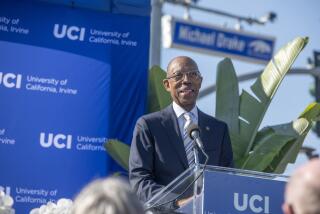Leadership 101
Most how-to-lead guides are written by students of power. There’s Machiavelli, of course; there’s Dale Carnegie and, most recently, there’s former GE chief executive Jack Welch. When university presidents address the public, they generally adopt a more dignified stance and take up less mundane topics: hence the University of California’s Clark Kerr on the modern multiversity and Harvard’s Derek Bok on what ails academe and government.
But “The Contrarian’s Guide to Leadership” by USC President Steven B. Sample is squarely in the how-to-lead tradition. His prescription for leadership is summed up in his book’s title: a “contrarian” approach resting on catch-phrase precepts such as “thinking gray,” “artful listening,” “artful procrastination” and “shooting your own horse.”
His precepts are sensible, at times insightful, and buttressed by the undeniable fact that, in terms of the things that measure a modern university’s success, Sample’s record at USC is an impressive one.
Indeed, the pinnacle of his career, and the climax of his book, is what he has done as president of USC. He arrived at a school that was in bad financial shape, with a mediocre reputation (except in football) and overshadowed by UCLA, that academic monolith across town.
Competition was the key to his success, and in this the university is no different from any other organization: “The awful feeling of being beaten or left in the dust by one’s competitors, the sweet taste of victory in a rough competition for a major contract or star faculty member or increased market share or elected office--these are the things that get followers’ blood stirring, thereby making the leader’s job a lot easier.”
He came up with a one-page “role and mission statement” and a strategic plan that included the goal of becoming one of the nation’s top 10 research universities, “strategic initiatives” in undergraduate education, interdisciplinary research and teaching, internationalization and making more of USC’s location in Los Angeles.
Under an able “vice provost for enrollment management” (an admissions director in non-bureaucratese), the school’s applicant pool scored higher on the SATs. USC made much--perhaps overmuch--of its success in wooing a few students also admitted to Yale. When Time magazine selected USC as “College of the Year 2000,” Sample quickly ordered 300,000 reprints and then a quarter of a million more: Every living member of the “Trojan Family” of alumni, faculty and students, it was said, got at least two copies, and every dead member got at least one. Hokey, perhaps, but it worked. Big gifts poured in, and USC’s endowment went from $440 million in 1990 to almost $2.2 billion in 2000: the ultimate measure of academic grace.
Sample readily equates running a university with running a business: “Should we sell the company? Should we buy out or merge with a competitor? ... Should we close down our medical school?” His realistic view of his job: “Along with helping to guide and shape one of the most noble and important institutions in society, a university president must also kiss a lot of frogs!”
At this point, it would be good form to tsk-tsk over the author’s readiness to equate running a university with running an appliance manufacturing company and to go on about it. But I found refreshing the unabashed way in which he assumes that there is nothing notably different about running a university from running any other organization. We’re a nation of go-getters, boosters, boomers, enthusiasts, so why shouldn’t an aspiring university be headed by someone with those values? John Silber, the Rudolph Giuliani of higher education, made Boston University a stronger, richer, better university. The flamboyantly entrepreneurial John E. Sexton has been called on to do the same as New York University’s president. USC, Boston University and New York University are large, private, urban universities. This, perhaps, is where the action is in higher education, much as it was in the great state universities during the century just past.
Sample’s is a very American story, and his is a very American book. If its readers can get over the belief that it is a form of lese-majeste for the university to be rudely yanked out of its ivory tower and plumped into the middle of the agora, they may find in this book a tale to warm the heart and mind.






